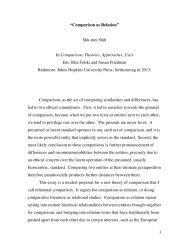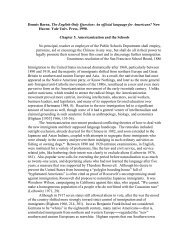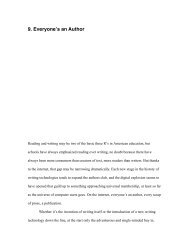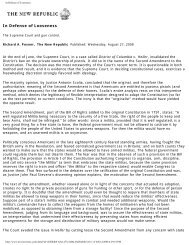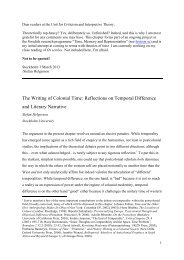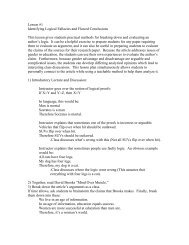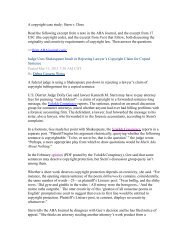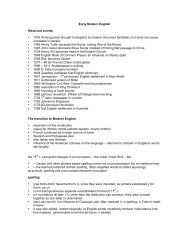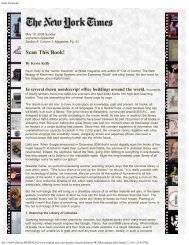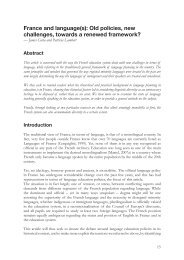Technics of the Subject: The Avatar-Drive Emily Apter - English
Technics of the Subject: The Avatar-Drive Emily Apter - English
Technics of the Subject: The Avatar-Drive Emily Apter - English
You also want an ePaper? Increase the reach of your titles
YUMPU automatically turns print PDFs into web optimized ePapers that Google loves.
9. Translation my own.<br />
10. See Leo Bersani, "<strong>The</strong> It in <strong>the</strong> I: Patrice Leconte, Henry James, and Analytic Love," in <strong>The</strong><br />
Henry James Review 27.3 (Fall 2006): 202-14.<br />
11. Samuel Weber, "Medium, Reflexivity and <strong>the</strong> Economy <strong>of</strong> <strong>the</strong> Self." Writing about Walter<br />
Benjamin's dissertation, "<strong>The</strong> Concept <strong>of</strong> Criticism in German Romanticism" [Der Begriff der<br />
Kunstkritik in der deutschen Romantik], Weber glosses Benjamin's insistence on <strong>the</strong><br />
transformative (alterity-producing) potential <strong>of</strong> thinking qua medium or pure mediacy:<br />
In contrast to Fichte, <strong>the</strong> Romantics do not shy away from affirming <strong>the</strong> "absolute" dimension<br />
<strong>of</strong> "reflection" and Benjamin explains this precisely through <strong>the</strong> notion <strong>of</strong> medium. But his use <strong>of</strong><br />
<strong>the</strong> term here, far from resolving <strong>the</strong> ambiguities <strong>of</strong> <strong>the</strong> Romantic tendency to regard reflection as<br />
Absolute, actually brings <strong>the</strong>m to <strong>the</strong> fore. <strong>The</strong>y can be described in <strong>the</strong> following way. On <strong>the</strong><br />
one hand, "medium " designates a process that is not simply instrumental or teleological but that<br />
seems to have a certain autonomy: it functions immediately, as indicated, and leaves nothing<br />
outside <strong>of</strong> itself. This in turn tends to construe <strong>the</strong> medium <strong>of</strong> reflection as ultimately a<br />
movement <strong>of</strong> <strong>the</strong> "self," a Selbstbewegung. On <strong>the</strong> o<strong>the</strong>r hand, however, this "movement" is<br />
precisely never simply circular or self-contained: it may be "continual" or "constant"––stetig is<br />
<strong>the</strong> German word Benjamin uses––and it may also entail a kind <strong>of</strong> unfolding or development––<br />
Entfaltung––but it is also and above all, a transformation. In <strong>the</strong> first pages <strong>of</strong> his dissertation,<br />
Benjamin emphasizes this point: "Under <strong>the</strong> term 'reflection' is understood <strong>the</strong> transformative<br />
(umformende)––and nothing but <strong>the</strong> transformative––reflecting on a form" (20/XX). Form is<br />
already a reflective category that in reflecting itself fur<strong>the</strong>r, alters and transforms itself. A certain<br />
alterity is thus essentially at work at <strong>the</strong> heart <strong>of</strong> <strong>the</strong> reflective movement. <strong>The</strong> ambiguity or<br />
tension thus results between such alterity, on <strong>the</strong> one hand, associated with a dynamics <strong>of</strong><br />
transformation and alteration, and on <strong>the</strong> o<strong>the</strong>r <strong>the</strong> notion <strong>of</strong> a movement <strong>of</strong> <strong>the</strong> self returning to<br />
itself also associated with <strong>the</strong> notion <strong>of</strong> reflection. <strong>The</strong> nature <strong>of</strong> <strong>the</strong> movement itself "reflects"<br />
this constitutive ambiguity: on <strong>the</strong> one hand it is "stetig," continual, on <strong>the</strong> o<strong>the</strong>r it moves by<br />
leaps and bounds.<br />
12. Interpassivity is a term used by Slavoj Zizek to "denote those abundant mechanisms we<br />
employ to avoid actually doing something. Hence, <strong>the</strong> hidden function <strong>of</strong> canned laughter––<br />
namely, that it laughs for us, so we don't have to feel obliged to respond to <strong>the</strong> program in an<br />
active mode, expending unnecessary energy laughing for ourselves. For Zizek, interpassivity is<br />
keyed to a conception <strong>of</strong> <strong>the</strong> body as a "desubjectivized multitude <strong>of</strong> partial objects" (180).<br />
13. Badiou, much like Zizek, articulates <strong>the</strong> desire for empty and/or mechanical structures <strong>of</strong><br />
subjectivity with quasi-religious discourses or credos <strong>of</strong> fidelity to <strong>the</strong> event are invoked to shore<br />
up <strong>the</strong> desire.<br />
14. My summary <strong>of</strong> remarks made by Brian Massumi in discussion following a presentation by<br />
Brian Massumi and Erin Manning titled "Arts <strong>of</strong> Relation," given at <strong>the</strong> conference "Architecture<br />
in <strong>the</strong> Space <strong>of</strong> Flows" held at Newcastle University on 24 June 2007. Massumi and Manning<br />
both work with notions <strong>of</strong> process, flow, and concrescence indebted to <strong>the</strong> work <strong>of</strong> Alfred North<br />
16


